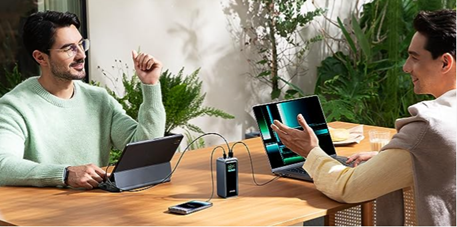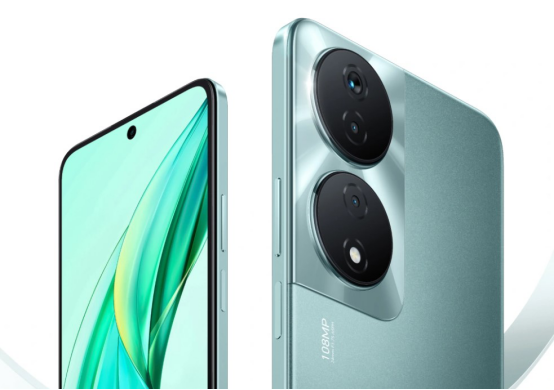When
choosing between wireless and cable charging, there are several aspects beyond
practicalities. Both approaches have merits, but your lifestyle and needs will
decide which is ideal. Since it's reliable and usually faster, cable charging
is still preferable. However, wireless charging's ease, modernity, and lack of
clutter are making it popular. You must understand these strategies, their
rates, and their use cases to select the best one. Now, let's examine these
differences.

What is the
Difference Between Wireless and Wired Charging?
Wireless
and cable charging mainly depend on how they charge your devices. To charge
your smartphone wired, use a USB-C or Lightning cable. This ensures a
continuous energy flow, which speeds charging. Wireless charging transfers
energy from a charging station to a smartphone via electromagnetic fields. This
method is slower due to transmission energy loss. To overcome this gap,
solutions like the Anker 3-in-1 Cube with MagSafe provide fast wireless charging,
especially for Apple devices. Each method has advantages depending on the
person's needs and preferences.
How Does Wireless
Charging Work?
The
idea of electromagnetic induction is the basis for wireless charging. When
plugged into an electrical outlet, the transmitter coil inside a wireless
charger—such as the Anker 3-in-1 Cube with MagSafe—creates an electromagnetic
field. You may charge your battery by interacting this magnetic field with your
device's receiver coil, which produces an electric current. By doing away with
the necessity for actual wires, this method provides a space-saving
alternative. Even while wireless charging is more convenient, the energy lost
during transmission makes it questionable if it can match the efficiency of
conventional charging.
How Does Wired
Charging Work?
A
more straightforward method is wired charging. The process is connecting your
gadget to an electrical outlet by means of a cord, either a Lightning or USB-C
one. Connecting the power source to the battery in your gadget is what the cord
is all about. In most cases, this approach leads to quicker charging times
because of the little energy loss that occurs during transfer. For customers
who value dependability and speed, wired charging is still a popular solution,
particularly for fast top-ups on hectic days. It guarantees a constant and
rapid charging experience with minimum energy waste, and it works especially
well with high-wattage adapters.

Key Features of
Wireless and Wired Charging
The
distinct advantages of wireless and cable charging make them suitable for
distinct types of users. The elimination of cords is a major benefit of
wireless charging. To simplify your charging setup, consider the Anker 3-in-1
Cube with MagSafe. It enables you to charge your iPhone, Apple Watch, and
AirPods all at once. The downside is that wired charging is usually faster and
more efficient than wireless. When time is of the essence, wired charging is
the way to go because of the quicker speeds and higher energy efficiency it
provides. Whether you choose one or the other depends on your charging habits
and preferences.
Is Wireless Charging
Slower Than Wired Charging?
Although
wireless charging has a slower track record than cable charging, that is
starting to change thanks to new innovations. A new generation of wireless
chargers, like the 15W 3-in-1 Cube with MagSafe from Anker, is rapidly catching
up, providing far quicker rates for Apple devices. Because of the direct
connection and consequent reduction in energy loss, wired charging is still the
faster option. But innovative wireless chargers from Anker are changing the
game by offering the best of both worlds: speed and convenience. Even if
wireless charging isn't quite as quick as cable charging, it's getting close,
so it's becoming a better choice for regular use.
Charging Speeds
Compared
Wired
charging is always the fastest option when comparing charging speeds. Users who
want their gadgets charged promptly will find wired chargers to be the most
suitable option since they may enable a fast power supply of 30W or more. Even
while wireless charging has been slower in the past, it has become much better
recently. In the case of the iPhone 15/14/13/12
series, Anker's 15W MagSafe technology offers very rapid wireless charging,
thereby eliminating the speed disparity. While wireless charging isn't quite as
quick as cable charging, the gap isn't as big in real life, so it's still a
good choice for those who value convenience.
Impact on Battery
Life and Efficiency
Considerations
like charging efficiency and battery life should be given serious consideration
when choosing between wireless and cable charging. The longer you charge your
device's battery via a wire, the better off your battery will be since it
generates less heat. Your battery may see increased degradation over time when
you charge wirelessly because of the energy loss and heat generated during the
transfer procedure. Good wireless chargers, such as Anker's 3-in-1 Cube, are
built to avoid these problems by transferring energy efficiently and generating
very little heat. The lifespan of batteries is still best achieved with wired
charging, but there are also high-quality wireless solutions that are catching
up.
Charging Speed
Variations Based on Devices
Comparing
older smartphones to newer versions reveals that not all gadgets charge at the
same pace. For example, wireless chargers designed for Apple devices, such as
the 3-in-1 Cube from Anker, will charge newer iPhones with MagSafe technology
more quickly. The flip side is that older devices could charge more slowly
since they don't support the latest wireless charging standards. Even while
charging via cable, newer gadgets can use the quicker standards, while older
ones may only be able to use the slower ones. For best results, make sure your
device is compatible.
Which is More
Convenient: Wireless or Wired Charging?
Compared
to other charging options, wireless charging is much more convenient. It
provides a cleaner, less cluttered charging experience as it doesn't need
cords. A 3-in-1 Cube with MagSafe, like the one from Anker, lets you charge
three devices at once, such as an iPhone, an Apple Watch, and AirPods. In terms
of efficiency and reliability, however, cable charging is still the way to go.
Wired charging is usually the way to go if you're in a hurry. Particularly in
settings where managing cables may be a pain, wireless charging excels when
usability and convenience are top concerns.
Portability and
Accessibility
Another
area where wireless charging really shines is in its portability. Users who are
always on the go will like the folding and small design of the Anker 3-in-1
Cube with MagSafe. As a result, you can charge many devices at once without
lugging along bulky cords, thanks to wireless charging. Though dependable,
wired charging may be a pain to transport, particularly when you need to bring
several connections and adapters. The smaller options, like Anker's MagSafe
charger, make wireless charging a more accessible choice for those who value
mobility and convenience.
Cable Management and
Durability
Managing
the cords is a major hassle with wired charging. Your charging accessories may
not last as long if you continually plug and unplug them. Because no cords are
required for wireless charging, this problem is rendered obsolete. The
connection stability of wired charging, on the other hand, is better and lasts
longer. There is always the risk of misalignment with wireless charging mats,
which might interrupt the charging process. However, wired chargers need more
upkeep in terms of cable management, but they provide a more consistent
experience with fewer points of failure.
Practical Use Cases
for Both Charging Methods
Depending
on the circumstances, both wireless and cable charging options might be useful.
The ease of just setting your smartphone on a pad makes wireless charging
perfect for daily usage, whether on a bedside table or workplace desk. Those
who want to charge many gadgets at once may find products such as the Anker
3-in-1 Cube to be ideal. On the other hand, if you're in a hurry or just need a
fast recharge, wired charging is the way to go. In a balanced charging system,
both approaches have their use.
Conclusion
Personal preference determines whether wireless or cable charging is superior. Cable charging is still the best option for speed and reliability due to its faster and more efficient energy delivery. Wireless charging offers the utmost convenience for simultaneously charging many devices and significantly minimizing clutter. For Apple users seeking mobility and speed, try the Anker 3-in-1 Cube with MagSafe. Wireless and cable charging benefits and downsides are lifestyle-related and should be carefully evaluated before choosing. Know the benefits of each technique to make an educated decision for your daily needs.



